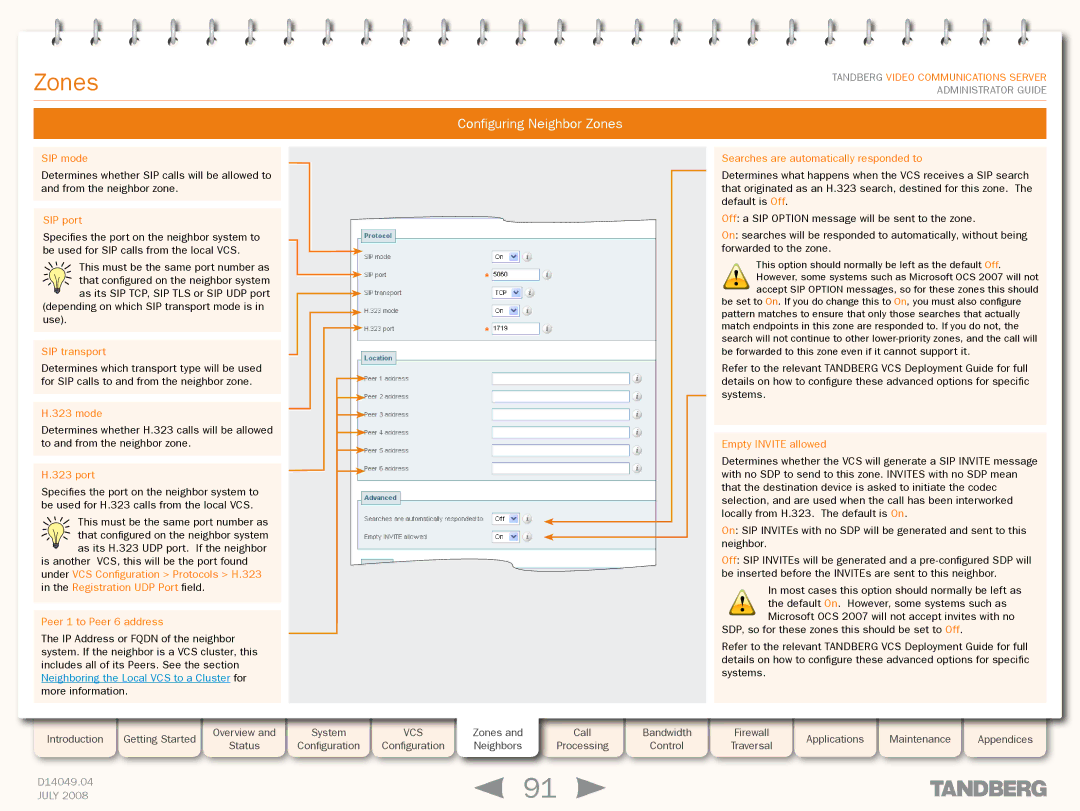
Grey Headline (continued)
Zones
TANDBERG VIDEO COMMUNICATIONS SERVER ADMINISTRATOR GUIDE
Configuring Neighbor Zones
SIP mode
Determines whether SIP calls will be allowed to and from the neighbor zone.
SIP port
Specifies the port on the neighbor system to be used for SIP calls from the local VCS.
This must be the same port number as
that configured on the neighbor system
![]() as its SIP TCP, SIP TLS or SIP UDP port (depending on which SIP transport mode is in use).
as its SIP TCP, SIP TLS or SIP UDP port (depending on which SIP transport mode is in use).
SIP transport
Determines which transport type will be used for SIP calls to and from the neighbor zone.
H.323 mode
Determines whether H.323 calls will be allowed to and from the neighbor zone.
H.323 port
Specifies the port on the neighbor system to be used for H.323 calls from the local VCS.
This must be the same port number as
that configured on the neighbor system as its H.323 UDP port. If the neighbor
is another VCS, this will be the port found under VCS Configuration > Protocols > H.323 in the Registration UDP Port field.
Peer 1 to Peer 6 address
The IP Address or FQDN of the neighbor system. If the neighbor is a VCS cluster, this includes all of its Peers. See the section Neighboring the Local VCS to a Cluster for more information.
Introduction | Getting Started |
| Overview and |
| System |
| VCS | Zones and | Call | Bandwidth |
| Status |
| Configuration |
| Configuration | Neighbors | Processing | Control | ||
|
|
|
|
| ||||||
|
|
|
|
|
|
|
|
|
|
|
D14049.04 |
|
|
|
|
|
|
| 91 |
| |
JULY 2008 |
|
|
|
|
|
|
|
| ||
Searches are automatically responded to
Determines what happens when the VCS receives a SIP search that originated as an H.323 search, destined for this zone. The default is Off.
Off: a SIP OPTION message will be sent to the zone.
On: searches will be responded to automatically, without being forwarded to the zone.
This option should normally be left as the default Off.
! However, some systems such as Microsoft OCS 2007 will not accept SIP OPTION messages, so for these zones this should
be set to On. If you do change this to On, you must also configure pattern matches to ensure that only those searches that actually match endpoints in this zone are responded to. If you do not, the search will not continue to other
be forwarded to this zone even if it cannot support it.
Refer to the relevant TANDBERG VCS Deployment Guide for full details on how to configure these advanced options for specific systems.
Empty INVITE allowed
Determines whether the VCS will generate a SIP INVITE message with no SDP to send to this zone. INVITES with no SDP mean that the destination device is asked to initiate the codec selection, and are used when the call has been interworked locally from H.323. The default is On.
On: SIP INVITEs with no SDP will be generated and sent to this neighbor.
Off: SIP INVITEs will be generated and a
In most cases this option should normally be left as ! the default On. However, some systems such as
Microsoft OCS 2007 will not accept invites with no SDP, so for these zones this should be set to Off.
Refer to the relevant TANDBERG VCS Deployment Guide for full details on how to configure these advanced options for specific systems.
Firewall |
| Applications |
| Maintenance |
| Appendices |
Traversal |
|
|
| |||
|
|
|
|
|
| |
|
|
|
|
|
|
|
